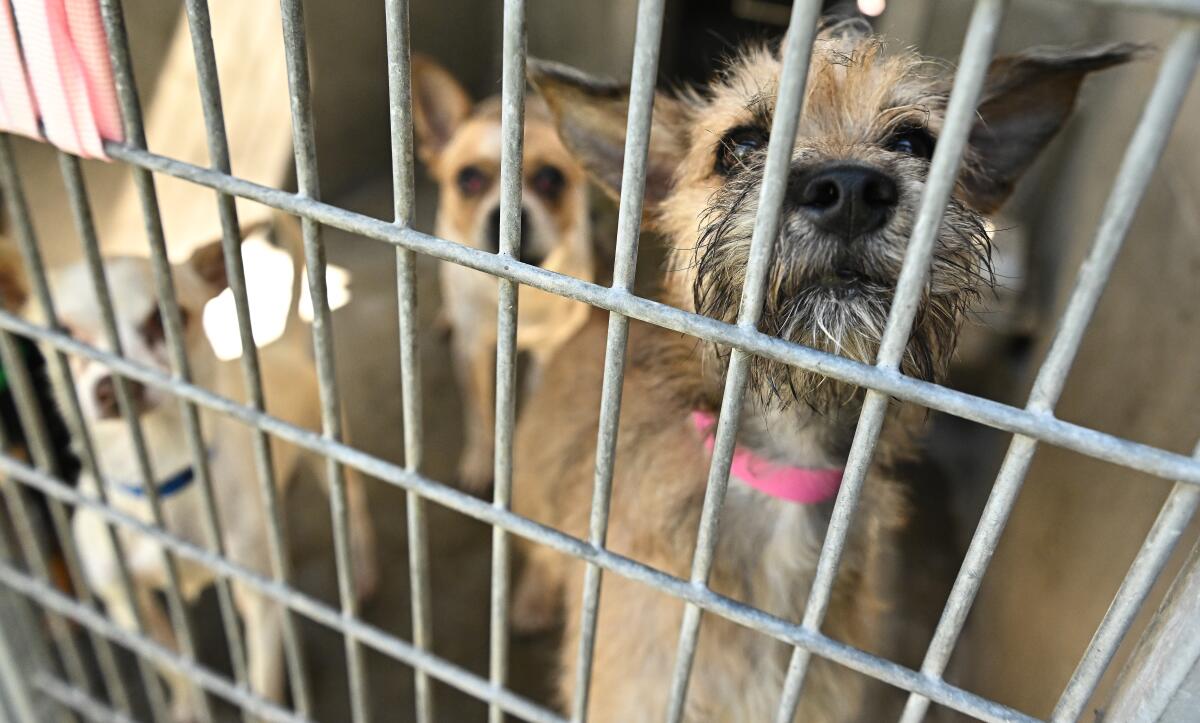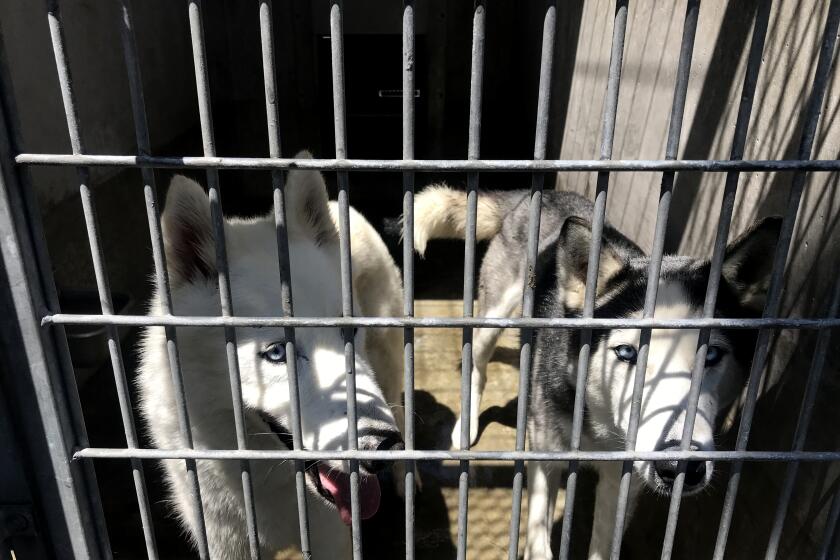The pets in L.A.’s animal shelters need help. Here’s what you can do

The stories coming out of L.A. city animal shelters are heartbreaking for any pet lover: overcrowding and staffing shortages have led to cramped and filthy kennels and inadequate care, and some dogs aren’t being walked for weeks.
Last month critics questioned Los Angeles Animal Services’ heavy reliance on volunteers to provide “enrichment, exercise and walks” rather than increasing funding for shelters in the city budget.
City leaders are holding public meetings in an attempt to address the issue. But for people who want to take immediate action, donating your time, a few needed items or money could ease some of the burden on current volunteers.
Pets in city shelters and ones run by nonprofits are still being adopted, said Ana Bustilloz, director of communications for the Society for the Prevention of Cruelty to Animals L.A. But: “The number of adoptions [at SPCA L.A.] is steady but has not met or surpassed pre-pandemic numbers,” Bustilloz said.
SPCA L.A. sees many factors at play, but economic challenges are at the forefront.
“Lack of affordable housing and stagnant wages affects all aspects of life, including the decision to bring a new pet into the home,” she said.
At shelters, she added, volunteers “are invaluable and very important to shelter operations.”
If you want to help shelter animals in and around L.A., here’s a rundown of the needs of some larger public and nonprofit shelters, as well as tips for helping smaller local shelters.
L.A.’s animal services agency is understaffed and relies on volunteers. At one overcrowded shelter, dogs sit in kennels for weeks or months without being walked.
L.A. Animal Services
What it does: This city department provides a temporary home to lost and stray animals at six shelters in Los Angeles. It offers adoption, licensing and microchipping services, and free spaying and neutering for pets belonging to low-income residents.
How you can help: The agency needs volunteers to help animals with play time, walking, socialization and engagement with people. Volunteers are also needed to assist with adoptions, greeting customers, photography, grooming and more.
Interested individuals will need to fill out an application and, once approved, complete training. L.A. Animal Services requires a minimum commitment of six hours a month for six months.
If you can’t meet the volunteer time commitment, you can also foster a dog or cat in your home. You can also make a monetary donation through the Animal Welfare Trust Fund, the Spay/Neuter Trust Fund and the Star Program. If you want to help stock the pet food pantry or provide supplies for the Boredum Busters Program, check out its Amazon wish list.
Experts share helpful tips for owners of dogs experiencing separation anxiety.
Best Friends Animal Society Los Angeles
What it does: The nonprofit organization collaborates with rescue groups, city shelters and individuals to stop animals from being euthanized. It hosts adoption and fundraising events, runs two shelters and leads the No-Kill Los Angeles initiative.
How you can help: The center has on-site and remote volunteer opportunities, including work that doesn’t require training. On-site work is done at one of the shelter’s two locations — in West Los Angeles or Mission Hills. Remote volunteering is needed to answer the shelter’s main phone line and assist with its social media accounts. You can also help with the shelter’s monthly clean-up days or special events.
All volunteers are asked to commit to two shifts a month. To get started, create a volunteer account online.
You can also make a monetary donation that goes toward adoption programs, spay and neuter services and No-Kill Los Angeles.
If you are planning to rent an apartment or house and have a pet, here’s a guide to searching for the right place and negotiating with a landlord.
Los Angeles County Animal Care and Control
What it does: The seven county shelters serve the unincorporated areas of Los Angeles County and 44 contracted cities. They provide animal control and rescue services 24 hours a day, seven days a week. Along with low-cost spaying and neutering services, county animal control officers patrol for lost, injured and abandoned animals, investigate animal cruelty cases and provide emergency rescues during natural disasters.
How you can help: You can donate to a specific shelter location by purchasing items from their Amazon wish list. Or you can make a donation to the department of animal control.
The county resumed virtual information sessions this year for interested volunteers. To start, volunteers 18 and older can fill out an application online — 16- and 17-year-olds need parental permission. Once your application is submitted and training is completed, volunteers are required to purchase a volunteer T-shirt ($11).
Which beaches in Los Angeles and Orange counties allow dogs? Check our list to find out.
SPCA Los Angeles
What it does: The Society for the Prevention of Cruelty to Animals Los Angeles is a nonprofit animal welfare organization that conducts cruelty investigations, responds to disasters and provides violence prevention and education programs and shelter services.
How you can help: The nonprofit needs volunteers to help animals in the shelter, to foster animals at home, assist youths in the violence prevention and humane education program, help with administrative duties, assist with fundraisers and take photos of shelter animals.
You can also make a donation online.
An L.A. City Council committee heard testimony about poor conditions for dogs, cats, rabbits, hamsters and other animals at overcrowded city shelters.
Pasadena Humane
What it does: The community-supported nonprofit organization provides shelter, care and adoption opportunities to animals. It also focuses on programs and services aimed at helping people care for and keep their pets with free and low-cost spay and neuter services as well as vaccines. It also has a pet food bank and an animal support call center.
How you can help: The organization has volunteer opportunities for people of all ages. Volunteers 15 and older are expected to commit to a minimum of 2 hours monthly for 12 weeks and can be a shelter greeter or ambassador or can foster a kitten. Younger volunteers can participate by being a shelter greeter and ambassador.
If you don’t have enough time to meet the minimum volunteer hours, you can be a one-time volunteer and assist with fundraising, adoptions and outreach events. For more information, email [email protected].
You can also make a one-time or monthly donation online.
For the record:
10:40 a.m. Aug. 3, 2022A previous version of this article referred to the nonprofit Pasadena Humane as Pasadena Humane Society. The organization changed its name in 2020.
April showers bring ... mosquitoes. Here are some pointers to help keep them away from your home. Pro tip: Do not leave pools of standing water on your property.
Helping local animal shelters
Matt Bershadker said that when people support local animal welfare organizations in any way they can, “it’s an act of admirable compassion.” Bershadker is the president and chief executive of ASPCA (not affiliated with SPCA L.A.), a national organization that works to rescue animals from abuse, pass humane legislation and share resources with shelters across the U.S.
“With many animal shelters and rescues experiencing increasing intake and placement challenges due to longer-stay animals with medical and behavioral needs, pandemic-related staffing shortages and decreased adoptions, community member support is more critical now than ever before,” he said.
To assist a shelter in your community not mentioned above, reach out or visit their website. Here are some questions to ask to learn how you can help.
- What opportunities are available? (And which ones make sense for me?)
- What is the minimum time commitment?
- What training is required?
- Are there other ways to help (donated items, monetary donations, fostering)?
- What does it take to foster a pet?
- How can I spread the word about how to help?
About The Times Utility Journalism Team
This article is from The Times’ Utility Journalism Team. Our mission is to be essential to the lives of Southern Californians by publishing information that solves problems, answers questions and helps with decision making. We serve audiences in and around Los Angeles — including current Times subscribers and diverse communities that haven’t historically had their needs met by our coverage.
How can we be useful to you and your community? Email utility (at) latimes.com or one of our journalists: Jon Healey, Ada Tseng, Jessica Roy and Karen Garcia.
More to Read
Sign up for Essential California
The most important California stories and recommendations in your inbox every morning.
You may occasionally receive promotional content from the Los Angeles Times.

















